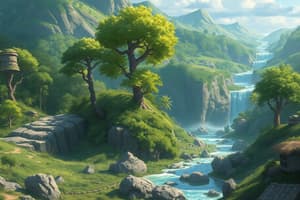Podcast
Questions and Answers
What characterizes an inverted pyramid of biomass?
What characterizes an inverted pyramid of biomass?
- Greater weight of decomposers compared to producers (correct)
- Higher number of producers than consumers
- More carnivorous animals than herbivorous animals
- Equal weight of herbivores and carnivores
In which ecosystem are the weights of herbivorous animals less than that of producers?
In which ecosystem are the weights of herbivorous animals less than that of producers?
- Desert ecosystem
- Aquatic ecosystem
- Forest ecosystem
- Grassland ecosystem (correct)
What does the pyramid of energy indicate about energy transfer at each trophic level?
What does the pyramid of energy indicate about energy transfer at each trophic level?
- Energy transfer is maximized at tertiary consumers
- 10% of energy is lost at each trophic level (correct)
- Energy is perfectly conserved at each level
- Energy increases as it moves up the trophic levels
Which nutrient cycle is characterized by the transfer of nutrients from the atmosphere?
Which nutrient cycle is characterized by the transfer of nutrients from the atmosphere?
What is the primary role of nutrients in an ecosystem?
What is the primary role of nutrients in an ecosystem?
What is true about the pyramid of biomass in a grassland ecosystem?
What is true about the pyramid of biomass in a grassland ecosystem?
Which statement describes the nutrient cycling process?
Which statement describes the nutrient cycling process?
What is a key feature of the pyramid of production?
What is a key feature of the pyramid of production?
Which of the following best describes producers in an ecosystem?
Which of the following best describes producers in an ecosystem?
Which type of consumer is specifically classified as herbivorous?
Which type of consumer is specifically classified as herbivorous?
What role do decomposers play in an ecosystem?
What role do decomposers play in an ecosystem?
What component of the ecosystem is primarily responsible for energy flow?
What component of the ecosystem is primarily responsible for energy flow?
What is the main difference between secondary and tertiary consumers?
What is the main difference between secondary and tertiary consumers?
What is included in the abiotic components of an ecosystem?
What is included in the abiotic components of an ecosystem?
Which of the following statements correctly classifies consumers in an ecosystem?
Which of the following statements correctly classifies consumers in an ecosystem?
Which term refers to organisms that eat both plants and animals?
Which term refers to organisms that eat both plants and animals?
What role do decomposers play in an ecosystem?
What role do decomposers play in an ecosystem?
Which of the following is NOT an abiotic component of an ecosystem?
Which of the following is NOT an abiotic component of an ecosystem?
Which factor is classified as a climatic factor in an ecosystem?
Which factor is classified as a climatic factor in an ecosystem?
What type of biome is characterized by cold, treeless regions often found in the Arctic?
What type of biome is characterized by cold, treeless regions often found in the Arctic?
Which of the following best describes the taiga biome?
Which of the following best describes the taiga biome?
Which component includes elements like calcium and magnesium within an ecosystem?
Which component includes elements like calcium and magnesium within an ecosystem?
What defines a biome in an ecosystem?
What defines a biome in an ecosystem?
Which of the following correctly categorizes aquatic ecosystems?
Which of the following correctly categorizes aquatic ecosystems?
Flashcards are hidden until you start studying
Study Notes
Ecosystem Overview
- Ecosystem combines "eco" (environment) and "system" (interacting components).
- Defined by Arthur G. Tansley in 1935, encompassing organisms and their physical environment.
- Comprises biotic (living) and abiotic (non-living) components.
Components of Ecosystem
-
Biotic Components:
- Producers (Autotrophs): Organisms that produce their own food, e.g., green plants.
- Consumers (Heterotrophs): Organisms that depend on others for food, subcategorized into:
- Primary Consumers: Herbivores (e.g., rabbits, cows).
- Secondary Consumers: Carnivores that eat herbivores (e.g., lions, tigers).
- Tertiary Consumers: Omnivores that consume both plants and animals (e.g., humans).
- Decomposers: Microorganisms that break down organic matter (e.g., bacteria, fungi).
-
Abiotic Components:
- Climatic Factors: Influence of temperature, humidity, sunlight, and rainfall.
- Inorganic Components: Essential minerals and elements (e.g., calcium, magnesium).
- Organic Components: Include dissolved oxygen, turbidity, pH, and carbon dioxide.
Types of Ecosystems
- Terrestrial Ecosystems: Include grasslands, forests, and deserts.
- Aquatic Ecosystems: Divided into:
- Freshwater ecosystems (e.g., lakes, ponds).
- Marine ecosystems (e.g., oceans, estuaries).
Ecosystem Characteristics
- Ecosystems depend on temperature, atmospheric parameters, climate, and plant growth.
- Ecosystems categorized as Biomes based on adaptive traits of plants and animals to local climates.
Types of Biomes
- Tundra: Cold, treeless regions found in the Arctic with scant rainfall and snow cover.
- Taiga: Largest terrestrial biome, coniferous forests beneath the tundra, noted for evergreen trees.
- Intermediate Ecosystems: Examples include forests with varying producer and consumer populations.
Ecosystem Energy Dynamics
- Pyramid of Biomass: Represents the weight of organisms across trophic levels, can be upright or inverted depending on the ecosystem structure.
- Pyramid of Energy: Indicates energy transfer between trophic levels, with a 90% energy loss at each step.
- Nutrient Cycling: Closed system facilitating exchange of nutrients between biotic and abiotic components, essential for organism metabolism.
- Biogeochemical Cycle: Circulation of essential elements like carbon, nitrogen, phosphorus, and sulfur in ecosystems.
Types of Nutrient Cycles
- Gaseous Cycle: Nutrient transfer from the atmosphere, including nitrogen, carbon, and water cycles.
Studying That Suits You
Use AI to generate personalized quizzes and flashcards to suit your learning preferences.




